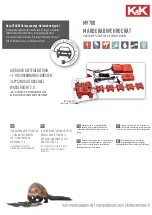
1
iS50 ATR Module
28
iS50 ATR Module User Guide
Thermo Scientific
• You see a change in the amount of water or carbon dioxide bands in the sample spectra.
• You see an unexpected change in the spectral baseline.
• The quality of your spectral data is reduced (more noise or spurious peaks in the
spectrum).
Sample bands are too small
The sample bands should be large enough that you can distinguish them from the spectral
baseline. The image below shows a spectrum with bands that are too small.
Figure 13.
ATR spectrum with weakly absorbing bands
If your spectrum looks like the one shown above, the following may have occurred:
• Not enough contact between the sample and crystal. Check the following:
• The pressure arm is applying adequate pressure to the sample. Place a flat, relatively
soft material such as a credit card on the crystal and tighten the pressure control
knob. If the pressure control knob spins freely or feels loose or stops prematurely,
contact our local service representative for technical support.
• You are using the correct tip for your sample material. See “
” for more information.
• The spectral range is set incorrectly. For more information, choose
Collect > Experiment
Setup > Bench tab > Help
and find “Max Range Limit and Min Range Limit.”
• You are collecting data in the near-IR region. Choose the
Touch Point Setup
button in
OMNIC software. If Region is set to NearIR, try selecting a different region. The NIR
region is generally not useful for ATR sampling because, in most cases, the depth of
penetration is too shallow to produce a usable spectrum.
• The sample concentration is low or the sample is weakly absorbing. If you are measuring
a liquid, concentrate it if possible. If you are measuring a solid, the sample may not be
compatible with the diamond ATR technique.







































